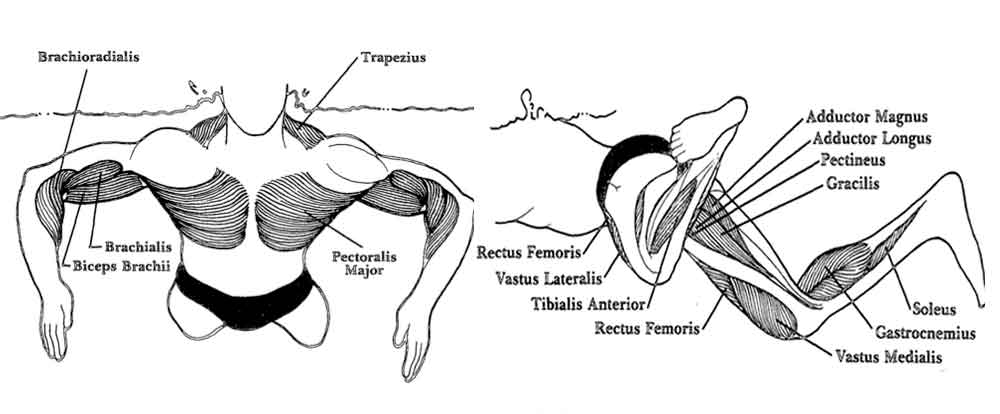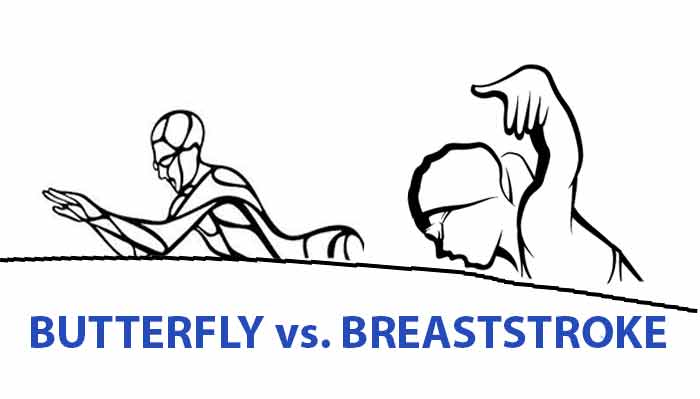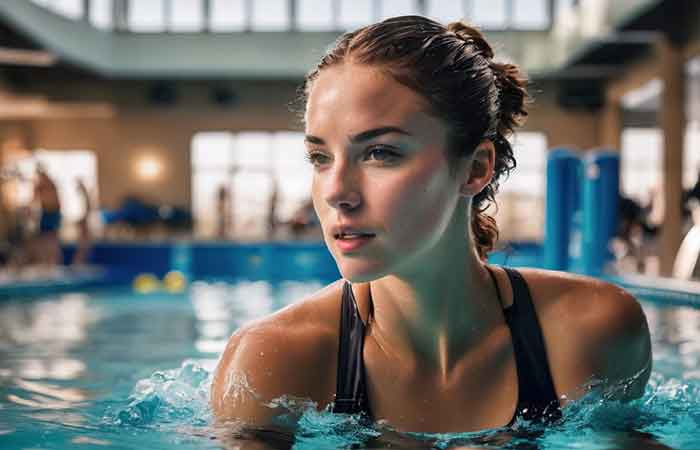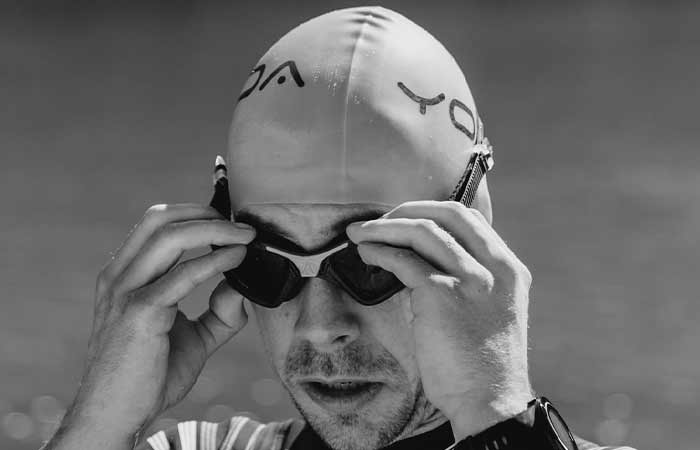How to Swim Breaststroke: Kick, Pull, Form, Drills & Tips
The breaststroke is competitive and recreational swimming style swum body facing down, while arms perform semicircular movements, and the legs doing a frog kick. In the initial learning stages, the head usually is above the water for easy breathing. It is the oldest, the most common but the slowest swimming stroke.
Read on for details on how to swim breaststroke; the form, kick, pull techniques plus drills. In addition, find more about the benefits in terms of the muscles it works out and the calories you can burn with this stroke.
Technique
Like most swimming styles, the starting position for the breaststroke is facing down with the hands forward and forming a straight line with the rest of the body all the way to the feet.
While each of the individual movements aren’t difficult, it’s their combination that tends to be difficult.
1. Breaststroke Pull (Arm Movement)
The arms move through three main phases namely the outsweep, insweep, and the recovery phase. In the outsweep, the palms face out from the streamlined position and separate slightly from the front to the side. This move turns into the insweep.
The insweep entails the movements of the hands downwards and backwards. Ensure that throughout the outsweep and the insweep, the elbows remain on a horizontal plane.
The hands are allowed to move until they’re almost vertical to the floor. The outsweep ends with the coming together of the hands at your chest and elbows close to your body.
The recovery phase entails returning to the starting phase of the outsweep. While together, push the hands straight forwards until they’re in line with the rest of the body.
The speed of the recovery phase is the slowest, increases with the outsweep, and peaks at the insweep.
2. Breaststroke Frog Kick
The frog-like movement for this swimming style comes form the movements of the legs. It’s known as the frog kick or the whip kick and has two stages mainly the positioning stage and the insweep stage. These stages are different from the starting streamlined position.
From the streamlined position in which the legs are straight backwards, the feet are brought together while the knees are still together. The feet then start moving to the side and outwards as you prepare for the thrust. Avoid letting the knees sink too much as this will increase the drag on your body.
The thrust stage entails pulling the legs together and into the starting point. This way, they generate thrust forwards. This thrust, together with the movement of the hands backwards, generates double thrust that propels your body forwards. The timing of the thrust from the legs should match that of the hands for the best results.
3. Form
The starting position for the body is the streamlined and flat state. From this state, you coordinate the body such that the arms and legs perform the thrust together.
This will require that when the arms are halfway in the insweep phase, the legs are ready to thrust and the head is out of the water for the breathing phase. Your body should be as horizontal as possible during this stage.
As such, the breaststroke style requires your body to be horizontal most of the time for the best speed.
After the thrust of the legs, the arms are in the recovery phase while the body is left to glide for a while. The length of the gliding phase will vary depending on how good you are at thrusting and generating force to propel yourself.
If you’re in a sprint, the technique is to spend more time stroking than gliding. The opposite is true if you’re covering a long distance. In general, the gliding phase for either case is the longest part of the entire stroke. Perfecting these motions earns you a major advantage.
4. Breathing
Like all the swimming styles, breathing is needed to provide aeration to the body for energy used in the propulsion. However, a swimmer is faster when fully submerged than when getting out of the water to breath in.
For the breaststroke style, the breathing is done when your head comes out of the water during the insweep phase of the hands. You breath in through the mouth and out through the mouth and nose. While the breathing in can only occur when you’re out of the water, breathing out can occur even underwater.
To attain the best rhythm as a swimmer for this style, you need let your head follow the movements of the spine. As the spine comes up, let the head come up with it too such that you get a period of time in which your body isn’t pushing ahead but taking in oxygen.
5. Starting
From a competitive point of view, the start of the breaststroke style is similar to the other styles whereby the swimmer jumps into the water, glides for a while then starts the strokes. The gliding phase occurs when the whole body is underwater and the hands are directly ahead to streamline the body.
Some advanced swimmers employ the frog start in which they pull the kegs forward then extend them outward in a quick motion while still in the air. This gives them a boost which enables them land further than their initial jump would allow.
There’s also the pull-out strategy in which the swimmer, after landing into the water, perform a pulldown, dolphin kick, and a whip kick then recover the hands to the streamlined position then start the strokes. These techniques give you the edge given that it’s difficult to gain an advantage over others in the normal stroke.
6. Turning and Finishing
The Two-Hand Touch rule applies to the turn and finish of this style as well. This rule means that, when turning or finishing the swim, both hands must touch the wall at the same time for it to count.
When turning, you touch the wall either in the gliding or recovery phase. It all depends on which phase is the faster of the two at that specific moment.
As your hands touch the wall, you bring your feet under you then turn to the side while still facing down. The legs then touch the wall and push you ahead for a little gliding before resuming the stroke.
Your hands should leave the wall one at a time while going for the new glide. As you glide off the wall, do an underwater pullout then another phase of gliding then normal swimming. Doing these motions under the water reduces the drag and makes you faster.
Breaststroke Drills & Tips
While a lot has gone into improving it, it remains one of the toughest to master when it comes to gaining speed and the body motions needed for competitive purposes.
This style, requires lots of power and resilience to gain considerable speed. As mentioned earlier, it is indeed the slowest of all swimming styles and gaining speed will require a lot of input on your end.
For improved speed and quick learning, following are drills that comprise leg and arm workouts/exercises plus tips for beginners, intermediate, competitive breaststroke swimmers and instructors
Basic Beginner Steps
Dryland Frog Kick Exercises for beginners
Workouts for competitive swimmers
Breaststroke Styles
The breaststroke has three main variations namely the fly/conventional style, undulating style, and the wave-style. While some of these styles are commonplace, some like the undulating one require years of practice and high levels of athleticism to pull off.
Conventional or Flat Style
This style is what’s been described in the sections above. While it’s not the fastest, it’s the most used and taught style of the breaststroke. It has a few minor variations to gain speed but remains simple in nature.
Undulating Style
The undulating breaststroke style is the least common mainly due to the difficulty of pulling it off. It’s a smooth type of swimming which requires an extremely high level of flexibility and fluidity to perform. As such, it’s reserved for performances and some athletes.
Wave-style Breaststroke
While the overall style is the same as the conventional style, the focus of this style is on reducing drag and hence increasing the speed of the swim. These variations are introduced to almost every stage of the stroke for better output of propulsion force.
The starting position is the same as the conventional one. However, the shoulders are slightly shrugged to reduce on the drag from the water.
As you start the stroke, you put more power and emphasis on the insweep motion. This is different from the conventional ones which puts emphasis on the outsweep. The result is that the head rises later in the stroke.
The movements of the hands are more circular in this style than in the others. It also entails higher than usual elbows that make it possible to generate maximum power from the movements of the torso especially the hip area.
To further reduce the resistance on the body, the feet move up and down with little movement in the thigh region. The result is that your feet generate more power with no vertical movements to increase the drag. Your body assumes a fluid motion in the water hence the name.
These styles are introduced for the most advanced of swimmers to gain speed during competitions. A casual swimmer is okay doing the conventional style which is already moderately difficult to master. If you’re into swimming, however, learning the wave-style can be a great addition to your swimming arsenal.
Breaststroke Benefits
Generally, swimming boasts of many health benefits whether you’re doing it for fun or competing against others. Among the most profound advantages of the breaststroke include the following:
Breaststroke for Muscle Toning
Swimming is the ultimate workout as it works all the parts of the body. Some of the muscles engaged when swimming breaststroke include,
- Back
- Chest
- Arms (biceps and triceps)
- Shoulder
- Glutes
- Quadriceps

At end, you will have an increased heart rate, better strength and endurance, and a toned body in no time. With a swim, you’ll have a better chance at getting fit than a tedious gym routine.
Breaststroke Calorie Burning (Weight Loss)
If you’re looking for some fun ways to shed some pounds, swimming breaststroke should be one of the items in your list.
Depending on your weight and speed, this stroke burns between 75 and 140 calories in every 15 minutes, which converts to 150 – 280 calories for a 30-minute session and between 300 and 560 calories in 60 minutes (each hour)
Helps in Recovery
Whether you’re recovering from a joint injury or damage in another part of the body, the fluid motions of swimming help you heal and retain your range of motions besides developing strength. Those with health conditions such as arthritis will also gain a lot from a swim.
Boosts your Mood
Swimming has been proven to help alleviate your moods to a significant extent. Water bodies in their own make people happier and swimming with water in contact with the body adds to that aspect. Besides, it’s an exercise which leads to the release of endorphins that make people happier.
As a whole, the breaststroke is a moderately easy style to learn. Those starting out on swimming will find it easy and quite forgiving when it comes to the body form when compared to the complex styles such as the butterfly and hybrid ones. It’s only inhibition is the slow speed one moves at.
History of Breaststroke
The breaststroke dates as far back as the Stone Age. Cave drawings showing this stroke have been found around the world including Egypt and the Babylonian region. In the drawings, the clear frog-like nature of the stroke are shown with some small variations in each case.
When sports involving swimming were first launched, they predominantly consisted of variations of the breaststroke from around the world.
The first breaststroke competition was held in the Summer Olympics of 1904 in Missouri in the United States. The style would be greatly improved by the likes of David Armbruster and Jack Sieg over the years.
Today, the breaststroke has been modified to be quite fast and have less drag on the body as one swims. Even with these changes, however, the style is still very slow compared to the likes of the butterfly and freestyle strokes.
Among the most famous swimmers known to use the breaststroke include Michael Phelps, Pernille Blume, Simone Manuel, Katie Ledecky and Amanda Beard.
These swimmers range from Olympic gold medalists to performance swimmers and many other categories. Some are attached to research centers where they continue refining the style to attain maximum speed and efficiency.
Breaststroke Olympics: Best Races Video
Further Reading
Following is a list of articles with more swimming information and other water sports
Swimming Strokes/Styles
- Different Types of Swimming Strokes, Styles & Names
- What is Sculling in Swimming? How to do it
- How to Tread Water- Techniques, Benefits & Exercises
- How to Swim Freestyle: Technique, Tips & Drills
- Butterfly vs Breaststroke Swimming
- How to Swim Elementary Backstroke- Technique, Drills & Tips
- How to Swim Sidestroke-Technique,Trudgen &Combat Drills & Tips
- How to Swim Backstroke-Technique, Drills & Tips
- How to Swim Butterfly: Technique, Drills & Tips
Swimming FAQs & Ideas
- How Many Calories Does Treading Water Burn?
- Can you Swim with Contacts in the Ocean/Pool?
- Can you Open your Eyes in the Salty Ocean or Chlorinated Pool Waters?







